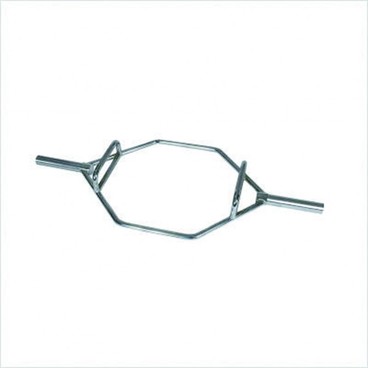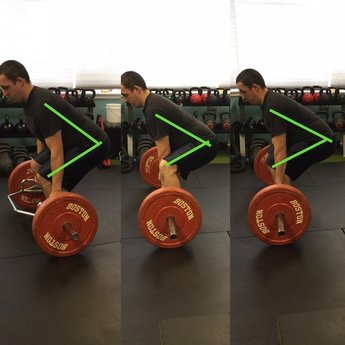|
OK surely you’ve shaken off whatever shock you went into after Sunday by now? I know my fiancé was absolutely agonizing over every minute of the ending. Those that don’t know I’m not a Patriots fan, but I sympathized with her agony, and a bunch of non-Pats fans got her through it Sunday. What!? How come you don’t like the Patriots Jarrod? Truth is, I pretty much didn’t have anyone to steer me to them until it was too late, I already latched on to the green and gold of the Packers. Anyone that knows me well, knows I am a mutt when it comes to my sports loyalties and this is neither news to them nor a surprise. Alright enough about that, seriously I could yammer about sports for way too long and you’d be asleep real fast, save a few of you. OK, where was I? Oh, yes the Trap Bar (or Hex Bar) Deadlift, some hate it and some love it. I figured I could lay out why either is OK but to too far on either side of the spectrum may not be the wisest thing. When it comes to your hinge pattern, the big money lift is of course a deadlift (I mean did you think I was going to say kickback or something?). More than likely a coach’s progression/regression table for the deadlift, not for the hinge movement or pattern, which is more general and opens a whole different can of worms, looks something like this RDL->Trap Bar Deadlift -> Sumo Stance Deadlift -> Conventional Deadlift- with the elevated variations of each filling in the gaps. The above isn’t perfect in all coaches view's, it’s just a general guideline. Some of the above variation may not even exist on some of their menu’s, and some of them may be flipped around. I could put in KB Deadlift as well, but that might lead off into a different tangent, trying to keep it simple here. For me, when I’m doing an assessment I’m hoping *crosses fingers* I can at least get someone to start with a Trap Bar deadlift for that movement pattern and progress or regress if necessary. Some schools of thought will NEVER consider anything beyond Trap Bar, which I think is a bit foolish in my humble opinion. I also know there are other school of thought that think any variation apart from conventional deadlift is dumb and well they’re dumb too. There’s a great set of Norwegian brothers that have said “There’s the right way, there’s the wrong way and there’s the Norwegian way.” This type of saying I’m sure most coaches would say fits their system well, maybe even in a somewhat arrogant manner…forgot where I was going with that. Anyway point is both the aforementioned schools of thought aren’t likely “The Right Way” but that’s OK if their system has worked for them and it’s been working for many years with more successes than failures, go for it and have fun. For the rest of us, the answer is that old cop out, it depends. Sit there and tell me a 6’8 trainee should be doing, and can do, the conventional deadlift variation…. I might call you crazy or look at you like you have 8 eyes. That person’s body likely isn’t going to cooperate to allow them to get to a safe position for that stance and honestly Trap Bar off the floor may not be a good idea either. You’ll probably be using Trap Bar, elevated to some degree, in order for them to maintain a safe, and effective, position to lift in. Also take into account how differently people’s shoulders and arms are put together too, some folks simply can’t maintain a solid grip on a bar, pain free, outside of a neutral grip. Sometimes it's just a matter of maintaining your center of gravity and most people would say it’s easier to maintain it when the weight is level with you/next to you as oppose to in front of you, even if only slightly. Also true is that if you are married to the Trap bar and never at least attempt to move someone to conventional or sumo stance deadlift, they may not realize their results as well as they could with just a Trap bar. The conventional or sumo deadlift get less, quady, as some call it and makes the posterior chain do a bit more of the work. I mean there’s a reason probably 9 out of 10 people can lift more on a Trap bar than a straight bar. It just allows for more engagement of the quads, which NOT a bad thing EVERY time. Sometimes you need to inflate an ego or something like that, so yeah go for the Trap bar, it’ll add at least 20 and upwards of 50 to your lift I’d guess. Some may never ever move away from a Trap bar and that’s OK too, things like boney structures and impingements/injuries may never a client move away from that particular variation. There's probably some out there that say, well if you do enough mobility work you should be able to get into whatever position you need to...quite false. Let's use me for example only because I've done all 3 variations as a part of my routine before. Below you'll find pictures of myself getting in position to lift from all 3 variations. I've drawn lines from and to the same 3 points (with a little wiggle room for human error), shoulders, hips, knees...heeead, shoulders, knees and toes. Wait where was I? Oh yeah, my positioning. Have a look and see if you can tell which one I can/should do and which, if any I should avoid. You can see in the Sumo (middle) and Trap Bar (left) my spinal alignment is about as good as it gets. It could be slightly better, but I took these pictures pretty much dead cold, so I'm giving myself a pass...because I can. The conventional (right) isn't awful, but not great, more on that in a second. You will notice the angle is a little wider for the Trap Bar than the other 2. This is because I have to/can sit into a deeper hinge with the sumo and conventional variation, thusly I will be required to use more posterior chain in order to complete the lift. This point alone I believe is worth at least exploring whether or not a trainee can do one of the variations that isn't the Trap Bar. Posterior chain is a must for life, especially athletics so if we can give the trainee more bang or the buck, LET'S DO IT! Please do keep in mind quads will be involved in all 3, they are needed to help get the bar off the floor, at the very least. It's just a matter of how much they can help throughout the lift. OK back to my point about mobility. I do a bunch of it and have for a few years now thanks to my friend Mike Anderson. I have yet to really find the ability to get into the conventional deadlift variation, 100% safely, consistently. I have good streaks and bad, currently post injury(s), I'm definitely not in one of those good streaks for this variation. Should I just continue to try to smash the square peg into the round hole...probably wise not to. Finally to land the plane, so to speak, being married to one side of the spectrum or the other is just a little bit silly in my mind. I'm not saying FORCE someone to do a variation that's not right for them, that's even worse. Just work at your mobility, your patterning and your technique, religiously and see what shakes loose. Everyone is different and some will be stuck using the Trap Bar eternally, others might be a bit more fortunate with a little help. That's what I got for today guys, hope you enjoyed. Go out there and get after it!
1 Comment
10/3/2022 12:51:00 pm
I Read this post. Here is advice that about Dice pattern. You can know more service the following website.
Reply
Leave a Reply. |
Details
AuthorJarrod Dyke, CSCS Archives
July 2024
Categories |


 RSS Feed
RSS Feed